As young people are spending more and more time on the internet, it is quite likely that cyberbullying will only increase in the years to come. Graphic by Sarah Mfinanga
The digital age has blurred the boundary between real and virtual worlds. Beneath the connectivity and resources the internet provides us with are victims of online harassment and bullying. The fast-paced industry was once a platform for freedom of expression and communication but has now allowed tormentors to increase the number of victims online, from online sexual harassment to body shaming and even bullying.
These situations have left most people specifically Canadians in a mental health crisis. In February 2022, Public Safety Canada organized a panel titled Online Dangers, Cyberbullying, and Online Child Sexual Exploitation to raise awareness about cyberbullying in Canada.
Both children and young adults who spend time online are most likely to become victims of online harassment. According to Cyberbullying Statistics Canada, 35 percent of Canadian adolescents experience bullying, 47 percent of Canadian parents believe their child is being bullied, 7 percent of Canadians experience cyberbullying, 1 in 10 Canadian children experiences online harassment, 17 percent of Canadians aged 18 to 24 suffer from cyberbullying and 89 percent of Canadian teachers believe cyberbullying is the number one safety issue in public schools.
Any form of bullying or harassment can be traumatizing, most students fall under the group of children and young adults and therefore have a high risk of being victims. Jason Lawrence, Lethbridge College Emergency & Security Manager and Conduct Officer says the most common form of online harassment that students have reported is through emails and texts. The Conduct Office adheres to the Student Rights and Code of Conduct policy, which allows students to have the right to a learning environment that respects freedom of expression and the advancement of human rights.
“When an individual believes that someone has contravened their right to a respectful learning environment, they are able to submit a non-academic misconduct report detailing the alleged incident. The Conduct office will review the complaint to determine whether it falls within the parameters of the policy and then will investigate the claim. If a student or students are found to have breached the code of conduct, sanctions may be applied,” said Lawrence.
The effects of online harassment and bullying across Canada may include less interest in school activities, absenteeism, depression and anxiety, low grades, increased risk of suicide, and even poor eating. These are just some of the many effects online harassment can cause. Seth Adema, a justice studies instructor at Lethbridge College says it can be challenging for instructors to know their students are victims of this problem.
“Online harassment…So, then it’s a lot of the time a real challenge for instructors because we don’t actually see what’s going on and therefore you only see the consequences of it.”
On the bright side, together we can put an end to this and make everyone’s life better. Some of the things a victim of online harassment can do is tell someone: do not try to deal with it on your own. Talk to a trusted adult and document it; this will help create a permanent record while this can be time consuming and emotionally difficult, report it, talk about it, and tell the police. For more information seek local help and services from Chinook Sexual Assault Centre at csacleth.ca or call 403-694-1094. If the abuse escalates and you feel threatened report it to the police.



